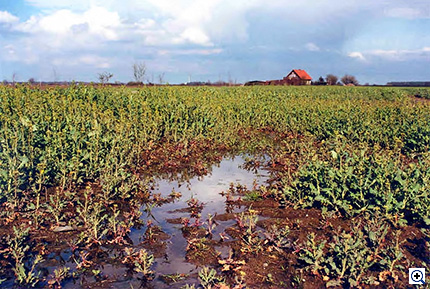Understanding flooding tolerance mechanisms using a tolerant dicot model system
Project code: MU 2755/6-1

Flooding damages in a rape field.
The predicted increase in the duration and frequency of flooding events in upcoming years due to the global climatic change demands extensive research into plant flooding-tolerance mechanisms, with the goal to improve survivability of crop plants under such stress conditions. Earlier studies in this area have largely focused on the monocot rice, being able to withstand several days of complete submergence and weeks to months of waterlogging (root flooding). In our project, we aim at establishing a flooding-tolerant dicotyledonous model plant system (Rorippa spec.) from the Brassicaceae family, similar to the well-established heavy metal-tolerant model species Arabidopsis halleri. For example, Rorippa sylvestris is able to survive complete submergence for 95 days (Sasidharan et al. 2013), while Arabidopsis could only withstand 20 days under similar conditions (Vashisht et al. 2011).
First, we will identify genes that are differentially regulated during submergence stress in the flooding-tolerant dicot genera Rorippa, Nasturtium and Cardamine in comparison to the flooding sensitive model plant Arabidopsis thaliana by use of RNAseq analyses. Besides the comparison between tolerant and sensitive species, species with different submergence survival strategies, namely the escape and quiescence strategies, will be compared with respect to global changes in gene expression. Second, we aim at making Rorippa species accessible to genetic modification by establishing transformation methods and analyzing the function of selected candidate genes from the first goal by means of gene knock-down or overexpression. Published methods for other Brassicaceae, including Arabidopsis halleri and Nasturtium officinale, will be the basis for this part of the project.
Publications related to the project
- Akman M, Bhikharie A, Mustroph A, Sasidharan R (2014) Extreme flooding tolerance in Rorippa. Plant Signal Behav. 9: e27847.


- van Veen H, Mustroph A, Barding GA, Vergeer-van Eijk M, Welschen-Evertman RA, Pedersen O, Visser EJ, Larive CK, Pierik R, Bailey-Serres J, Voesenek LA, Sasidharan R (2013) Two Rumex species from contrasting hydrological niches regulate flooding tolerance through distinct mechanisms. Plant Cell 25: 4691-4707.


- Sasidharan R, Mustroph A, Boonman A, Akman M, Ammerlaan AM, Breit T, Schranz ME, Voesenek LA, van Tienderen PH (2013) Root transcript profiling of two Rorippa species reveals gene clusters associated with extreme submergence tolerance. Plant Physiol 163: 1277-1292.


- Vashisht D, Hesselink A, Pierik R, Ammerlaan JM, Bailey-Serres J, Visser EJ, Pedersen O, van Zanten M, Vreugdenhil D, Jamar DC, Voesenek LA, Sasidharan R (2011) Natural variation of submergence tolerance among Arabidopsis thaliana accessions. New Phytol 190: 299–310.


- Lee SC, Mustroph A, Sasidharan R, Vashisht D, Pedersen O, Oosumi T, Voesenek LA, Bailey-Serres J (2011) Molecular characterization of the submergence response of the Arabidopsis thaliana ecotype Columbia. New Phytol 190: 457-471.


- Mustroph A, Lee SC, Oosumi T, Zanetti ME, Yang H, Ma K, Yaghoubi-Masihi A, Fukao T, Bailey-Serres J (2010) Cross-kingdom comparison of transcriptomic adjustments to low oxygen stress highlights conserved and plant-specific responses. Plant Physiol 152: 1484-1500.





